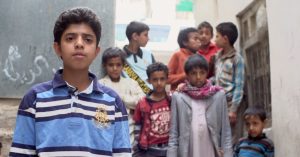By Jess Miller

Go to the Washington Post’s website—or the New York Times, or CNN—and try to find an article about the thousands of children driven from their homes, forced to fight, or dying of starvation in the Middle East. Odds are the task will require a lot of scrolling past the latest updates on the Trump Presidency, and not much else. And these children’s tragedies are nothing new. In his 1862 novel, Les Miserables, Victor Hugo railed against child neglect and abuse, among other social issues. Over 150 years later, these problems—child neglect overlooked, abuse ignored, abandonment unheeded, what Hugo referred to as “the child’s atrophy through darkness”—persist to a horrific extent in the streets of Yemen and Syria.
“The child’s atrophy through darkness”—despite being as potent a problem today as it was at the time of Hugo’s writing—often goes unnoticed and unaddressed. In order for solutions to this “atrophy” to be considered, it is imperative that the “darkness” be eradicated, that these issues be brought to light.
The Middle East is the epicenter of a civil war and a famine that has been called “the worst humanitarian crisis in United Nations history.” According to Aljazeera, a leading source for news on the Middle East, “in Yemen…two thirds of the population—18.8 million people—need aid and more than seven million people are hungry.” To date, more than 400,000 Syrians have been killed—according to the United Nations—in a civil war that has raged since 2011.
In these tragedies, there is little worse suffering than that of children. In fact, the United Nations defines famine as “when more than 30 percent of children under age five suffer from acute malnutrition.” In Syria, 40 % of all children have been driven from their homes, and 80 % of the nation’s child population is in need of humanitarian assistance (UNOCHA). Citing some of Hugo’s own statistics from Les Miserables, “at the time [around 1832] …truant children abounded in Paris. The statistics gave an average of two hundred and sixty homeless children, picked up annually by police on their rounds…This abandoning of children…was not discouraged by the old monarchy…A hatred for educating the children of the people was dogma.” These “children of the people” Hugo calls “gamins.” In the novel, as in the Middle East today, these children live on the streets, uneducated, hungry, determined to survive but nonetheless abandoned.
Yet, for all these Middle Eastern children’s suffering, their plight is rarely reported by mainstream news outlets. Like the gamins of Paris, they are neglected in their native countries, ignored by the rest of the world. What is written is practically hidden—buried under headline after headline about American politics or the occasional human interest story. Even on webpages dedicated to “World” news, the Middle East is ignored in favor of places like Europe and Russia.
Finding solutions to these problems raises divisive issues—but simply reporting on the crises should not be part of the controversy. Intervention of any kind requires recognition. That is, these children’s misfortune must be recognized on a much broader scale. The deaths of children anywhere in the world should be privileged over “Dog opens 3 doors to make crafty escape from animal hospital” (The Washington Post), “Has coffee gotten too fancy?” (The New York Times), or “‘Thor: Ragnarok’ Makes Marvel History” (CNN).
It is naïve and unfair to ignore the children of the Middle East, to cast them and the region into darkness. It is clear to see from Hugo’s descriptions in Les Miserables that the suffering of these children is a universal problem. And if history is an example, the problem will continue. It is necessary, then, to shed light on these issues—starvation, neglect, abandonment—to take the first step on the road to their potential resolution.
